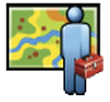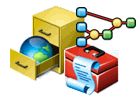An introduction to Analysis in ArcGIS
Geoprocessing in ArcGIS incorporates two components:
- a large collection of spatial analysis tools and
- a framework for using these tools.
Using geoprocessing we can use tools to carry out a workflow. ArcGIS has a rich suite of geoprocessing tools for performing spatial analysis. A typical geoprocessing tool performs an operation on an ArcGIS dataset (such as a feature class, raster, or table) and produces a new, output dataset as the result of the tool.
The components of any workflow that form your analysis is broken down into each a small, yet important, operation on geographic data. Tools can easily be chained together, feeding the output of one tool into another. This allows an infinite number of geoprocessing models (tool sequences) that help you automate your work, solve complex problems, and create custom tools.
Methods and results can easily be shared with others by packaging your workflow into a geoprocessing package, or you can create web services from your workflows.
An example of sharing analysis
This video shows a hot spot analysis model developed on ArcGIS for Desktop, being publishing to ArcGIS for Server. A web application can then use this geoprocessing service to perform real-time hot spot analysis of crime in San Francisco. This video is from the 2011 Developer Summit and uses ArcGIS for Desktop 10.1. The web application can be found here.
Using Tools In ArcGIS
System Toolboxes, in Catalog, are sub-divided into a number of key toolboxes (.tbx), within each are a number of tools that provides analysis tools for related topics. In any analysis you may need to combine tools from a number of different toolboxes. Finding tools can be done easily using the Search facility in Catalog, where a right click gives you a number of options including, locating the tool in catalog, opening the tool, running the tool in batch mode or learning more about the tool.
Geoprocessing tools can be used in a number of different ways either directly from the Catalog window, using ModelBuilder or in Python.
ModelBuilder
ModelBuilder is a visual programming language that allows you to chain together sequences of analysis tools, feeding the output of one tool into another, to create a repeatable analysis method that gives meaningful results. Geoprocessing tools and ModelBuilder are used extensively by GIS analysts to understand our world and solve problems. It is easy to get started with Modelbuilder, the Executing tools in ModelBuilder in the help documentation gives a great beginners step-by-step guide. A number of more advanced topics have been covered in a series of blogs (Part 1, 2, 3, 4 and 5).
This video presentation is from the 2011 Esri Developer Summit. All the models and data used in this presentation are available on ArcGIS.com
Python
Python is a free, cross-platform, open-source programming language. It is used as the scripting language for geoprocessing users as it extends across ArcGIS including data analysis, conversion and management. There is a Resouce Center specifically for Python although many of the tools we use for geoprocessing and analysis will use Python. Many of these tools that we have built can be found in our Geoprocessing Gallery.
This story was contributed by Linda Beale, analysis and geoprocessing team




